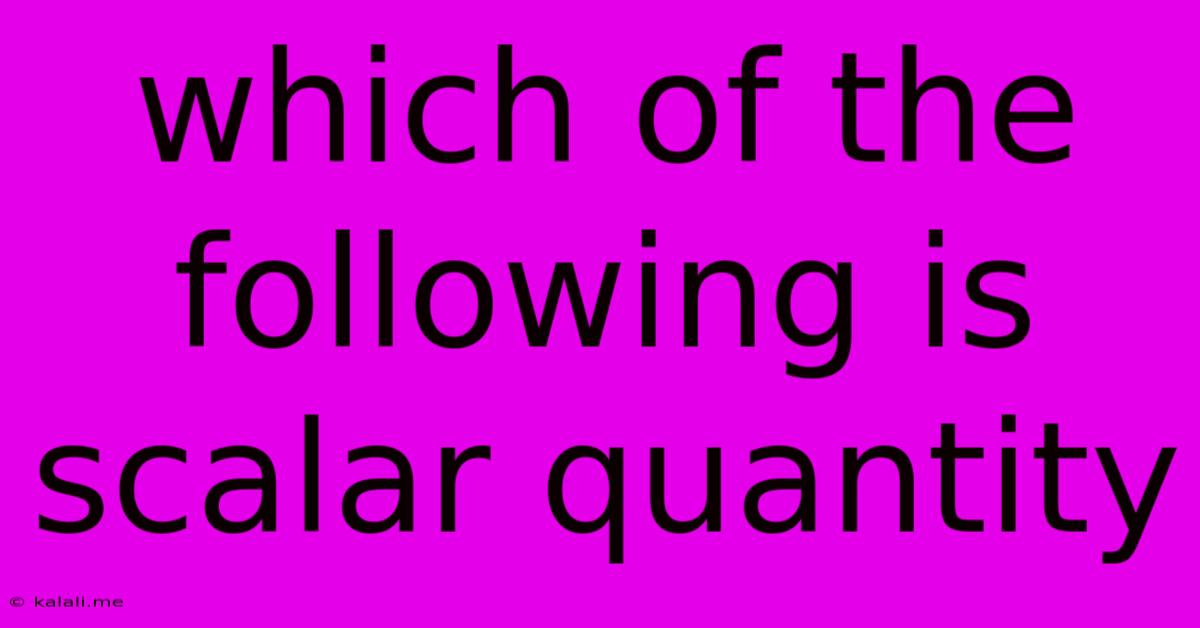Which Of The Following Is Scalar Quantity
Kalali
Jun 11, 2025 · 3 min read

Table of Contents
Which of the Following is a Scalar Quantity? Understanding Scalars and Vectors
This article will delve into the fundamental difference between scalar and vector quantities, ultimately answering the question: which of the following is a scalar quantity? We'll explore the definitions, provide examples, and help you confidently identify scalar quantities in various scenarios. Understanding this distinction is crucial in physics, mathematics, and many other scientific fields.
What are Scalar Quantities?
A scalar quantity is a physical quantity that is fully described by a single number (its magnitude) and an associated unit. It only has size or magnitude. Think of it as a simple number that represents a measurement. Examples include:
- Mass: The amount of matter in an object (kilograms, kg).
- Temperature: The degree of hotness or coldness (Celsius, °C; Fahrenheit, °F; Kelvin, K).
- Speed: The rate of change of distance (meters per second, m/s). Note: speed is different from velocity (explained below).
- Energy: The capacity to do work (Joules, J).
- Time: Duration of an event (seconds, s).
- Volume: The amount of three-dimensional space occupied by an object (cubic meters, m³).
- Density: Mass per unit volume (kilograms per cubic meter, kg/m³).
- Distance: The length between two points (meters, m).
What are Vector Quantities?
In contrast to scalars, a vector quantity possesses both magnitude and direction. It requires both a numerical value and a specified direction to be fully described. Examples include:
- Velocity: The rate of change of displacement (meters per second, m/s, and a direction). This is different from speed, which only considers magnitude.
- Displacement: The change in position of an object (meters, m, and a direction). This differs from distance.
- Force: A push or pull (Newtons, N, and a direction).
- Acceleration: The rate of change of velocity (meters per second squared, m/s², and a direction).
- Momentum: Mass in motion (kilogram meters per second, kg⋅m/s, and a direction).
Identifying Scalar Quantities: A Practical Approach
To determine if a quantity is scalar, ask yourself: Can I fully describe this quantity with just a number and a unit? If yes, it's a scalar. If you need to specify a direction as well, it's a vector.
Let's consider a specific example: Suppose you have a list of quantities: speed, velocity, mass, force, and energy.
- Speed is a scalar; you only need to know the magnitude (e.g., 60 mph).
- Velocity is a vector; you need both magnitude (e.g., 60 mph) and direction (e.g., North).
- Mass is a scalar (e.g., 10 kg).
- Force is a vector (e.g., 10 N upwards).
- Energy is a scalar (e.g., 100 J).
Conclusion
Understanding the distinction between scalar and vector quantities is fundamental to many scientific disciplines. By focusing on whether a quantity requires only magnitude or both magnitude and direction for complete description, you can confidently identify scalar quantities from a given list. Remember the key: scalars have only magnitude, while vectors possess both magnitude and direction. This simple distinction will greatly enhance your understanding of physics and related fields.
Latest Posts
Latest Posts
-
How Much Is 20 Pounds Of Pennies Worth
Jul 01, 2025
-
How Much Does A Gallon Oil Weigh
Jul 01, 2025
-
How Many Crackers In A Sleeve Of Saltines
Jul 01, 2025
-
How Many Years Are In 48 Months
Jul 01, 2025
-
What Grade Is A 12 Out Of 15
Jul 01, 2025
Related Post
Thank you for visiting our website which covers about Which Of The Following Is Scalar Quantity . We hope the information provided has been useful to you. Feel free to contact us if you have any questions or need further assistance. See you next time and don't miss to bookmark.